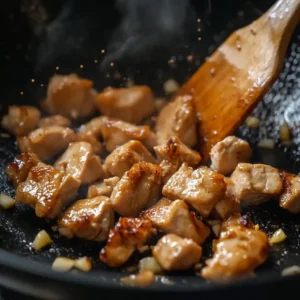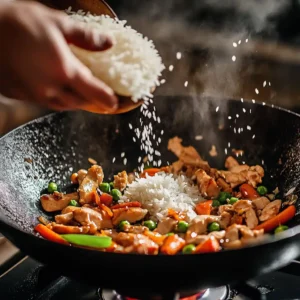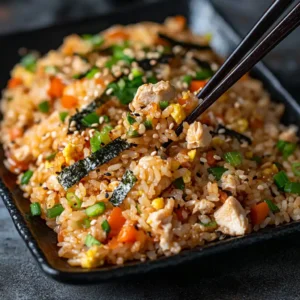Craving the umami flavors of Japan but don’t have time for complicated recipes? This Japanese Chicken Fried Rice (Yakimeshi) is your answer! In just under 30 minutes, you can create a restaurant-quality dish that perfectly balances savory flavors with tender chicken and fluffy rice.
Unlike its Chinese counterpart, Japanese-style chicken fried rice, or Yakimeshi as it’s authentically called, features a more subtle seasoning that allows each ingredient to shine. With readily available ingredients and my foolproof technique, you’ll master this staple of Japanese home cooking faster than delivery would arrive.
Whether you’re a weeknight warrior looking for quick dinner solutions or a Japanese cuisine enthusiast wanting to recreate those izakaya flavors at home, this chicken fried rice Japanese style recipe delivers satisfaction in every bite. Let me show you how the simple combination of day-old rice, tender chicken, and traditional Japanese seasonings transforms into a mouthwatering meal your family will request again and again.
Table of Contents
Understanding Yakimeshi: The Heart of Japanese Fried Rice
Yakimeshi (焼き飯) literally translates to “grilled rice” in Japanese, and it’s the authentic name for what we often call Japanese-style fried rice. Unlike its more heavily seasoned Chinese counterpart, Yakimeshi embraces simplicity and celebrates the natural flavors of each ingredient.
What truly sets chicken fried rice Japanese style apart is its cooking technique and seasoning philosophy. While Chinese fried rice often incorporates many sauces and seasonings, Yakimeshi relies primarily on the umami from soy sauce and the aromatic punch of garlic and ginger. The result is a lighter, more delicate flavor profile that still delivers incredible satisfaction.
The Key Technique Difference: Yakimeshi is cooked at extremely high heat with quick, continuous movement. This high-heat stir-frying ensures that each grain of rice becomes perfectly coated with the seasonings while maintaining its individual integrity – no clumping allowed!
The Secret Weapon: Day-Old Rice
Perhaps the most crucial element in creating authentic chicken Yakimeshi is using day-old rice. Fresh rice contains too much moisture, resulting in a sticky, mushy fried rice. When rice has had time to cool and dry out in the refrigerator, each grain becomes firmer and develops slightly dehydrated edges that will crisp beautifully when stir-fried.
Pro Tip: If you’re in a hurry and don’t have day-old rice, cook fresh rice with about 10% less water than usual, spread it on a baking sheet, and place it in the refrigerator uncovered for 30-45 minutes. This quick-cooling method will help evaporate excess moisture.
Ingredients for Perfect Chicken Fried Rice Japanese Style
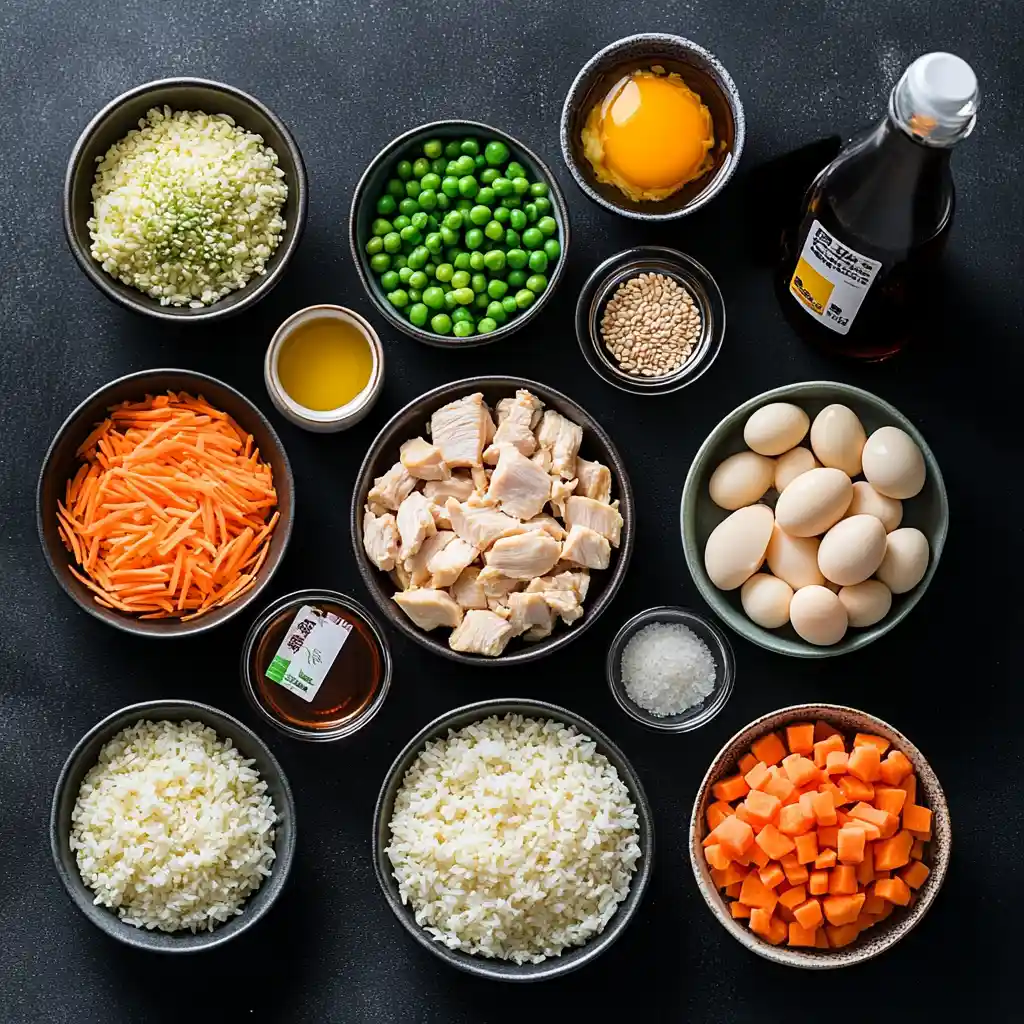
For the Rice Base:
- 3 cups day-old cooked Japanese short-grain rice (about 1 cup uncooked)
- 2 tablespoons neutral oil (such as canola or vegetable oil)
- 2 large eggs, lightly beaten
- 250g (8.8 oz) boneless chicken thigh, cut into small bite-sized pieces
- 2 green onions/scallions, thinly sliced (white and green parts separated)
- 1 medium carrot, finely diced (about ½ cup)
- ½ cup frozen green peas, thawed
- 2 cloves garlic, minced
- 1 teaspoon fresh ginger, grated
For the Seasoning:
- 3 tablespoons soy sauce (preferably Kikkoman or Tamari for authentic flavor)
- 1 tablespoon honey or 2 teaspoons sugar (adds subtle sweetness)
- 1 tablespoon rice vinegar (for light acidity)
- 2 teaspoons sesame oil
- ¼ teaspoon white pepper
- Salt to taste
For Garnish:
- Nori (seaweed), cut into thin strips
- Bonito flakes (optional)
- Toasted sesame seeds
- Remaining green parts of scallions
Ingredient Substitutions:
- If you can’t find Japanese short-grain rice, medium-grain rice is an acceptable alternative. Long-grain rice will work but won’t deliver the same authentic texture.
- Chicken breast can replace thighs, but reduce cooking time slightly to prevent drying.
- For additional umami flavor, add 1 teaspoon of dashi powder (non-alcoholic variety) or ½ teaspoon of mushroom powder.
You can find authentic Japanese ingredients at Asian grocery stores or through online retailers like Umami Mart or Amazon’s Japanese Grocery section.
Step-by-Step Instructions for Chicken Fried Rice Japanese Style

1. Prep Your Ingredients
Before heating your wok or pan, have everything prepared and within reach. The cooking process happens quickly, so organization is key!
- Break up any clumps in your day-old rice using your fingers or a fork.
- Cut chicken into small, uniform pieces about ½-inch in size.
- Dice carrots into small, even cubes.
- Separate white and green parts of scallions.
- Mince garlic and grate ginger.
- Combine soy sauce, honey or sugar, rice vinegar, and white pepper in a small bowl.
2. Cook the Egg
- Heat a wok or large skillet over high heat until smoking.
- Add 1 tablespoon of oil and swirl to coat.
- Pour in beaten eggs and let them set for 5 seconds.
- Using quick motions, scramble the eggs just until they’re set but still soft, about 15-20 seconds.
- Transfer eggs to a plate and set aside.
3. Cook the Chicken
- In the same wok, add another tablespoon of oil if needed.
- Add chicken pieces and spread them out in a single layer.
- Let them sear undisturbed for 1 minute until golden on one side.
- Stir-fry for another 2-3 minutes until chicken is cooked through.
- Add minced garlic, grated ginger, and white parts of scallions.
- Stir-fry for 30 seconds until fragrant.
4. Add Vegetables
- Add diced carrots to the wok and stir-fry for 1-2 minutes until slightly softened.
- Add thawed green peas and stir to combine.
5. Add Rice and Seasonings
- Add the day-old rice to the wok, breaking up any remaining clumps.
- Using a scooping and tossing motion, stir-fry the rice for 2-3 minutes until it’s heated through.
- Pour the soy sauce mixture around the edges of the wok (not directly on the rice).
- Immediately toss everything together until the rice is evenly coated with the seasonings.
- Add the cooked egg back to the wok and gently fold it into the rice.
6. Finish and Serve
- Drizzle sesame oil over the rice and toss to combine.
- Taste and adjust seasoning with salt if needed.
- Turn off heat and add half of the green scallion parts.
- Transfer to serving bowls or plates.
- Garnish with remaining green scallions, nori strips, bonito flakes, and sesame seeds.
Tips for Perfect Yakimeshi (Japanese Chicken Fried Rice)
Master the Rice
For truly authentic chicken fried rice Japanese style, the rice quality and preparation are paramount:
- Always use Japanese short-grain rice (such as Koshihikari) for authentic texture.
- Don’t just refrigerate rice—spread it on a tray before refrigerating to maximize surface area for moisture evaporation.
- If your day-old rice has formed hard clumps, sprinkle 1-2 teaspoons of water over it and microwave for 10 seconds before stir-frying.
Perfect Your Technique
- Wok Hei Matters: The “breath of the wok” or that smoky flavor comes from proper high-heat cooking. Your wok should be smoking hot before adding ingredients.
- Keep Things Moving: Constant motion prevents burning while encouraging even cooking.
- Don’t Overcrowd: Cook in batches if necessary—overcrowding lowers the temperature and leads to steaming instead of frying.
- Egg Technique: For authentic Yakimeshi, the egg should be partially cooked separately, then finished with the rice, creating both distinct pieces and egg-coated rice grains.
Flavor Enhancements
- Add a small pat of butter at the final stage for rich restaurant-style flavor.
- For umami depth, sprinkle ¼ teaspoon of dashi powder when adding the seasonings.
- Japanese mayonnaise (Kewpie) makes an excellent serving condiment on the side.
- A dash of apple cider vinegar can add brightness without using alcoholic ingredients.
Delicious Variations of Japanese Chicken Fried Rice
Spicy Japanese Chicken Fried Rice
Add 1-2 teaspoons of Japanese seven-spice blend (Shichimi Togarashi) or 1 tablespoon of sriracha sauce when adding the soy sauce mixture. The heat beautifully complements the savory elements of the dish.
Shrimp Yakimeshi
Substitute 250g of peeled, deveined shrimp for chicken. Reduce cooking time to just 1-2 minutes until shrimp turn pink. This seafood variation is particularly popular in Japanese households.
Vegetable Yakimeshi
Skip the chicken and double up on vegetables. Add sliced shiitake mushrooms, corn kernels, and diced bell peppers for a colorful vegetarian option. Consider adding small cubes of firm tofu for protein.
Garlic Chicken Fried Rice Japanese Style
Double the garlic (4 cloves instead of 2) and add 1 tablespoon of garlic chives or garlic scapes when available. The aromatic punch makes this variation irresistible for garlic lovers.
Serving Suggestions
For an authentic Japanese dining experience, serve your chicken fried rice Japanese style with:
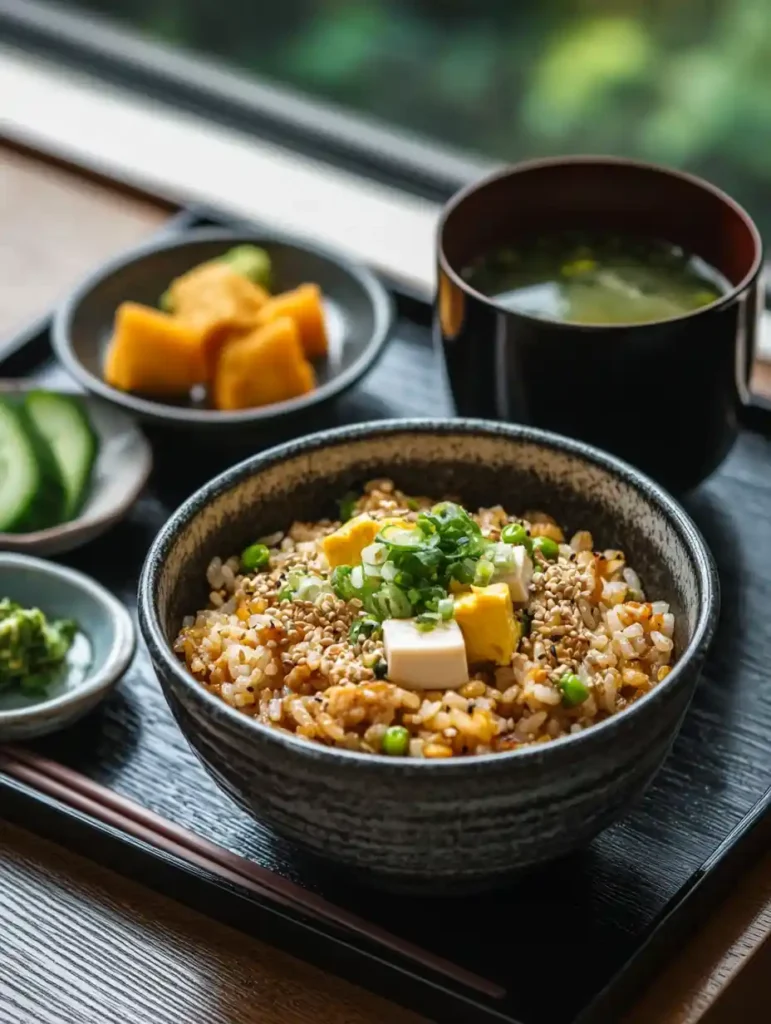
- A bowl of simple miso soup
- Japanese pickles (tsukemono)
- A small side salad with wafu (Japanese-style) dressing
- Chilled cucumber with sesame oil and salt
- A cold barley tea or hot green tea
For a complete meal, consider adding a side of gyoza (Japanese dumplings) or karaage (Japanese fried chicken) to complement your quick Japanese chicken fried rice.
The Cultural Significance of Yakimeshi
In Japan, Yakimeshi isn’t just delicious—it’s practical. Japanese home cooks developed this dish as a clever way to use leftover rice and whatever proteins or vegetables were on hand. It exemplifies the Japanese concept of mottainai (avoiding waste) and the aesthetic principle of simplicity.
While chicken Yakimeshi is widely enjoyed at home, you’ll also find it in countless izakayas (Japanese pubs) and casual restaurants across Japan, often served as a satisfying end to a meal or as a standalone quick lunch.
Unlike the elaborate preparation of sushi or the precision of tempura, Yakimeshi celebrates everyday Japanese cooking—accessible, adaptable, and always delicious.
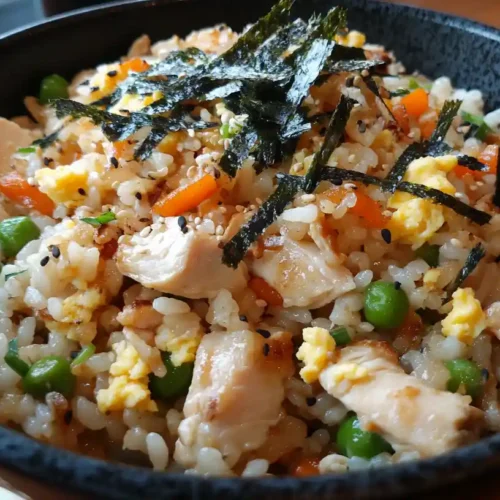
Chicken Fried Rice Japanese Style (Authentic Yakimeshi)
Ingredients
For the Rice Base:
- 3 cups day-old cooked Japanese short-grain rice about 1 cup uncooked
- 2 tablespoons neutral oil such as canola or vegetable oil
- 2 large eggs lightly beaten
- 250 g 8.8 oz boneless chicken thigh, cut into small bite-sized pieces
- 2 green onions/scallions thinly sliced (white and green parts separated)
- 1 medium carrot finely diced (about ½ cup)
- ½ cup frozen green peas thawed
- 2 cloves garlic minced
- 1 teaspoon fresh ginger grated
For the Seasoning:
- 3 tablespoons soy sauce preferably Kikkoman or Tamari for authentic flavor
- 1 tablespoon honey or 2 teaspoons sugar adds subtle sweetness
- 1 tablespoon rice vinegar for light acidity
- 2 teaspoons sesame oil
- ¼ teaspoon white pepper
- Salt to taste
For Garnish:
- Nori seaweed, cut into thin strips
- Bonito flakes optional
- Toasted sesame seeds
- Remaining green parts of scallions
Ingredient Substitutions:
- If you can’t find Japanese short-grain rice medium-grain rice is an acceptable alternative. Long-grain rice will work but won’t deliver the same authentic texture.
- Chicken breast can replace thighs but reduce cooking time slightly to prevent drying.
- For additional umami flavor add 1 teaspoon of dashi powder (non-alcoholic variety) or ½ teaspoon of mushroom powder.
Instructions
- Prep Your Ingredients
- Before heating your wok or pan, have everything prepared and within reach. The cooking process happens quickly, so organization is key!
- Break up any clumps in your day-old rice using your fingers or a fork.
- Cut chicken into small, uniform pieces about ½-inch in size.
- Dice carrots into small, even cubes.
- Separate white and green parts of scallions.
- Mince garlic and grate ginger.
- Combine soy sauce, honey or sugar, rice vinegar, and white pepper in a small bowl.
- Cook the Egg

- Heat a wok or large skillet over high heat until smoking.
- Add 1 tablespoon of oil and swirl to coat.
- Pour in beaten eggs and let them set for 5 seconds.
- Using quick motions, scramble the eggs just until they’re set but still soft, about 15-20 seconds.
- Transfer eggs to a plate and set aside.
- Cook the Chicken

- In the same wok, add another tablespoon of oil if needed.
- Add chicken pieces and spread them out in a single layer.
- Let them sear undisturbed for 1 minute until golden on one side.
- Stir-fry for another 2-3 minutes until chicken is cooked through.
- Add minced garlic, grated ginger, and white parts of scallions.
- Stir-fry for 30 seconds until fragrant.
- Add Vegetables
- Add diced carrots to the wok and stir-fry for 1-2 minutes until slightly softened.
- Add thawed green peas and stir to combine.
- Add Rice and Seasonings
- Add the day-old rice to the wok, breaking up any remaining clumps.

- Using a scooping and tossing motion, stir-fry the rice for 2-3 minutes until it’s heated through.
- Pour the soy sauce mixture around the edges of the wok (not directly on the rice).
- Immediately toss everything together until the rice is evenly coated with the seasonings.
- Add the cooked egg back to the wok and gently fold it into the rice.
- Finish and Serve

- Drizzle sesame oil over the rice and toss to combine.
- Taste and adjust seasoning with salt if needed.
- Turn off heat and add half of the green scallion parts.
- Transfer to serving bowls or plates.
- Garnish with remaining green scallions, nori strips, bonito flakes, and sesame seeds.
Notes
- Calories: 375 kcal
-
Fat: 14g
- Saturated Fat: 2g
- Protein: 21g
-
Carbs: 42g
- Fiber: 3g
- Sugars: 5g
- Cholesterol: 150mg
- Sodium: 750mg
- Potassium: 330mg
- Vitamin A: 80% DV
- Vitamin C: 20% DV
- Calcium: 4% DV
- Iron: 10% DV
Why You’ll Love This Recipe
This chicken fried rice Japanese style recipe strikes the perfect balance between authenticity and accessibility. Using ingredients you can find at most grocery stores, you’ll create a dish that transports you straight to a Tokyo izakaya. The combination of tender chicken, fluffy rice, and umami-rich seasonings creates a deeply satisfying meal that’s far greater than the sum of its parts.
Whether you’re a Japanese cuisine novice or a seasoned home cook looking to expand your repertoire, this Yakimeshi recipe delivers restaurant-quality results with minimal effort. The next time you have leftover rice, don’t just reheat it—transform it into an authentic Japanese delicacy your whole family will love.
Have you tried making Yakimeshi before? What’s your favorite variation? Share your experiences in the comments below!



